I grew up eating bugs. When I would visit my grandparents in Yokohama, they used to offer me inago no tsukudani いなごの佃煮, rice grasshoppers cooked in soy sauce, as an afternoon snack. At first, I tried to refuse as nicely as I could. It looked pretty gross. But they told me eating bugs would make me smarter (I was young and believed them). After timidly taking a bite, I was surprised! I actually liked it.
You may think this is rare, but Japan has bug eating traditions that are similar to other Asian countries1. The oldest records of uniquely Japanese entomophagy (bug eating) are from the Edo period2. They were eaten mostly in farming villages, but during World War II, the practice spread all over Japan. Food was scarce and bugs were readily available. But in the postwar period, more food options became available and the insect population decreased due to pesticide use, so bug eating became less common. Very few people in Japan were eating bugs by choice…until recently.
Today, there is a movement led by gourmet chefs, activists, authors, and food experts who are promoting insects as a delicious food of the future.
- Why Do People Eat Insects?
- Shoichi Uchiyama, The World Famous Insect Chef
- Japanese Insect Recipes
- Edible Bug Vending Machines
- Japanese Canned Insect Review
- Insects Commonly Eaten in Japan
- Eating Bugs in Japan: Resources
- Eating Bugs by Choice, Not Out of Necessity
Why Do People Eat Insects?
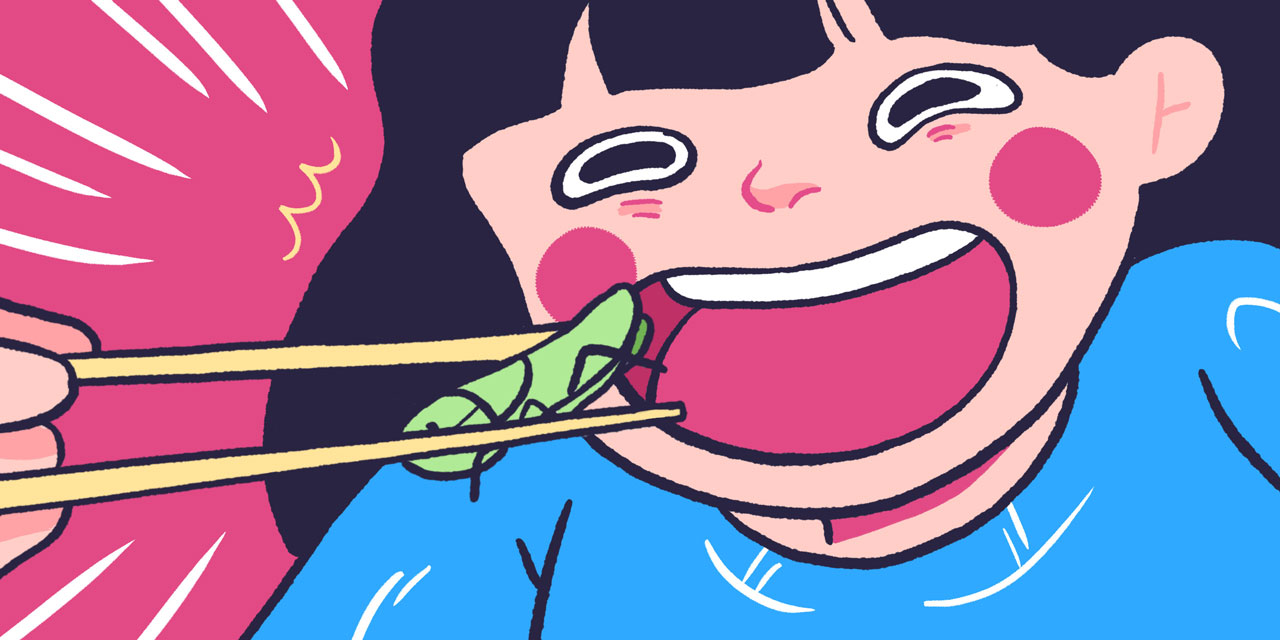
Not only are bugs delicious, but eating them has other benefits too. Many experts are calling edible insects the "food of the future" because of their high nutritional value, rapid reproduction, and accelerated growth. Here are some smart reasons to bug out:
-
Cost Effectiveness: According to the Food and Agriculture Organization of the United Nations (FAO), bugs offer the same amount of protein as pork, poultry, and mutton with two to four times less feed.
-
Accelerated Growth: Insects grow fast. While cows take at least two or three years to mature before they can be eaten, most bugs take less than six months.
-
Health Benefits: Not only are insects sustainable, they’re highly nutritious. The FAO recommends edible insects as a healthy food source with high fat, protein, vitamin, fiber, and mineral content.
-
Promotes Long Life (Maybe): Although it’s not scientifically proven, eating insects for food may help you live longer. Nagano, the prefecture that eats the most bugs in Japan, is also the prefecture with highest life expectancy. Not a sure thing, but it could be true…
Shoichi Uchiyama, The World Famous Insect Chef
When it comes to edible insects, Shoichi Uchiyama, the world famous bug chef, is one of the leaders of the insect-eating movement. Uchiyama is from Nagano, where this particular dietary tradition is common. He has been researching insect cuisine since 1999 and has published many insect cookbooks and publications. He even holds events with his Edible Insect Study Group konchuuryouri kenkyuukai 昆虫料理研究会.
Bug Cooking Workshop
One regular event held by Mr. Uchiyama’s research group is a bug cooking workshop in Tokyo. Mr. Uchiyama and the participants enjoy cooking and tasting their bug meals together.
In the video above, the group makes three different bug dishes:
- Fluffy Omelette Rice of Bee Larvae ( ふわふわハチの子オムライス)
- Potato Salad with Giant Water Bug ( タガメ風味のポテトサラダ)
- Baby Ant Minestrone ( アリの子のミネストローネ)
Shoichi Uchiyama, the world famous bug chef, is one of the leaders of the insect-eating movement.
Mr. Uchiyama’s favorite of these three dishes was the Potato Salad with Giant Water Bug. He says people who don’t eat bugs aren’t able to tell there are bugs in the potato salad, and always ask where the elegant, pear-like taste comes from. His bug dishes look creative and unique, and most people who participate in these events become more interested in the idea of edible insects.
Uchiyama keeps updating the recipes, so you can enjoy seasonal bug meals at this event. It costs 2,500 yen to attend and you need a reservation. But if you’re up for a culinary adventure, sign up here.
Japanese Insect Recipes
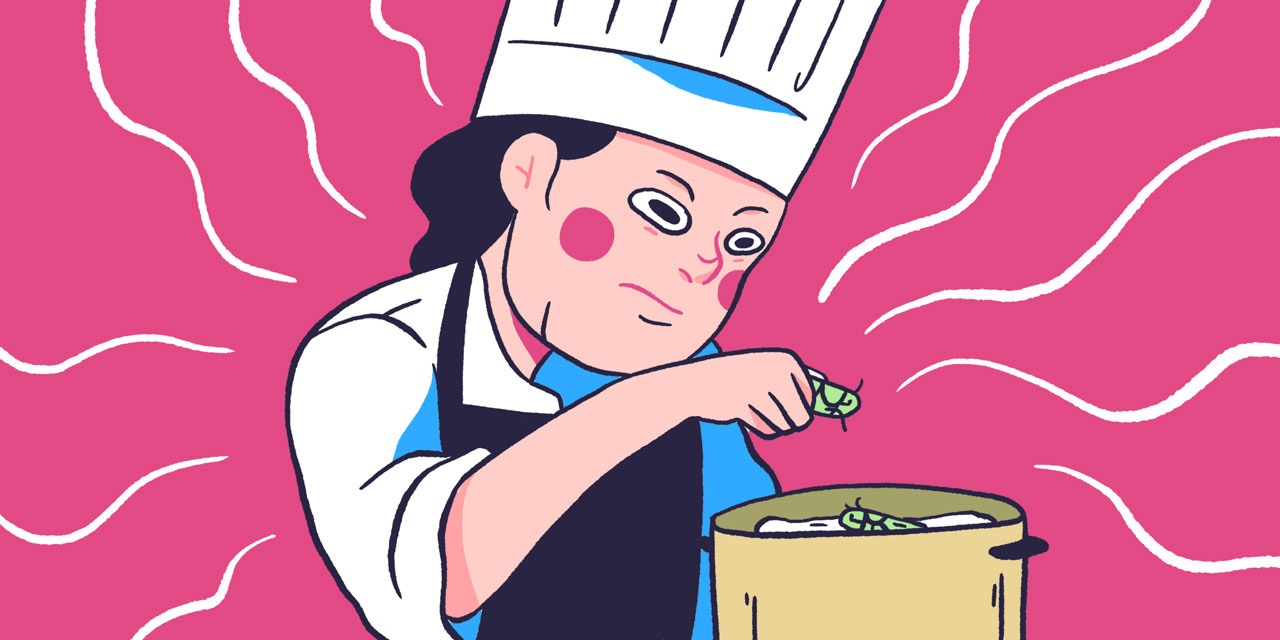
If you don’t get a chance to attend the workshop, you can always cook bugs at home. Mr. Uchiyama offered up a couple bug recipes at past events (the ones mentioned above), and we have them written in English right here!
But before you go out snatching bugs off trees, you need to know how to cook them. Also, you should figure out if you’re allergic. If you’re allergic to crab and shrimp, you might want to avoid eating bugs, since they both have tropomyosin that can cause allergic reactions.
Omurice with Bee Larvae Recipe
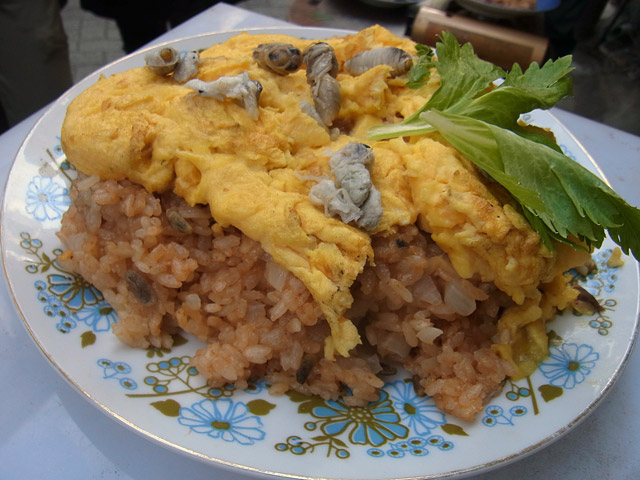
Ingredients for 4 servings:
- Ketchup Rice:
- 12 oz white rice
- ½ onion
- 1 bouillon cube
- 1 tbsp ketchup
- ½ tbsp Worcester sauce
- 3 ½ oz Japanese hornet larvae or pupae
- 1 tbsp ketchup
- Omelette:
- 2 eggs
- ½ tbsp mayonnaise
- 1 tbsp butter
- Topping:
- 16 Japanese hornet pupae
Directions
- Wash rice and soak in water in rice cooker. Chop onion.
- Add bouillon cube, ketchup, and Worcester sauce. Add a little less water than what’s needed.
- Put onion and bee larvae on the top. Start rice cooker.
- Once cooked, add ketchup and stir. Adjust taste with salt and pepper.
- To make omelette, mix eggs and mayonnaise well.
- Heat a pan over high heat. Add butter.
- Pour mixed eggs before butter is melted completely. Mix as if drawing a circle with chopsticks.
- Cover rice with omelette.
- Top with boiled pupae seasoned with salt and pepper. Add ketchup, if desired.
Baby Ant Minestrone Recipe

Ingredients for 4 servings:
- 1 ½–2 oz baby ants
- 1 Taiwanese water bug
- ½ onion
- ½ carrot
- 1 celery
- 1 tomato
- 1 clove garlic
- 1 tbsp olive oil
- 1 bay leaf
- 1 bouillon cube
- 2 ½ cups boiled water
- Salt and pepper to taste
Directions
- Boil baby ants lightly, and put in a colander.
- Boil Taiwanese water bug and open shell with scissors. Take meat out. Cut each shell into 4 pieces.
- Cut onion, carrot, celery, and tomato into half-inch cubes. Crush garlic with the back of knife.
- Heat olive oil in a pot, and stir-fry garlic lightly until aromatic. Add onion, carrot, and celery. Continue to stir-fry until they get tender.
- Add tomato and stir-fry lightly. Add boiled water, bouillon, and bay leaf. Cover and boil for 20 mins.
- Add baby ants and meat of Taiwanese water bug to boil. Salt and pepper to taste.
- Top with shells of Taiwanese water bug.
Rice Grasshopper Granola Bars Recipe
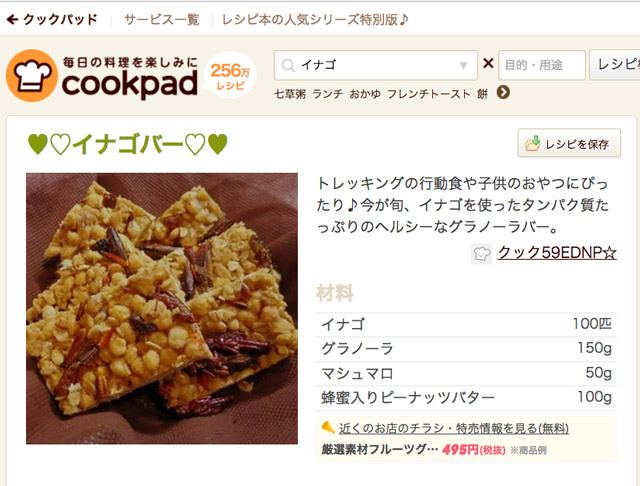
This one isn’t from Mr. Uchiyama. I found it on Cookpad, Japan’s largest recipe sharing service. Just in case your neighbor gifts you a sack full of grasshoppers, here’s a recipe you can use to make them into healthy granola bars!
Ingredients:
- 100 rice grasshoppers
- 5 ½ oz granola
- 5–6 large marshmallows
- 3 ½ oz peanut butter with honey
Directions
- Leave rice grasshoppers in a bag for a day to let them poop. Put them in the freezer to kill them.
- Stir-fry grasshoppers until they get crispy. Remove legs and antennae, if burnt.
- Microwave marshmallow and peanut butter to melt. Mix with granola and rice grasshoppers.
- On parchment paper, mold the "dough" into a large granola bar shape. Spread grasshoppers around evenly, and press the dough so there are no spaces.
- Set in fridge to chill. Cut into pieces, and enjoy!
Edible Bug Vending Machines

If you’re too lazy to hunt for bugs and cook them, don’t worry! There are other options. Japan is a land of convenience, and this extends to their tasty, tasty insects.
You can buy edible bugs anytime 24/7. In Tokyo’s Inokashira park, there’s a vending machine with two kinds of bugs that come in cans:
- Hanakuyoujirushi Rice Grasshopper Kanroni hanakuyoujirushi inago kanroni 花九曜印いなご甘露煮 (900 yen)
- Hanakuyoujirushi Brand Bee Larvae hanakuyoujirushi hachinoko hanakuyouni 花九曜印蜂の子花九曜煮 (2,300 yen)
Both of these products are kinds of 佃煮 tsukudani. Tsukudani is the traditional way of cooking with soy sauce, sugar, and sake.
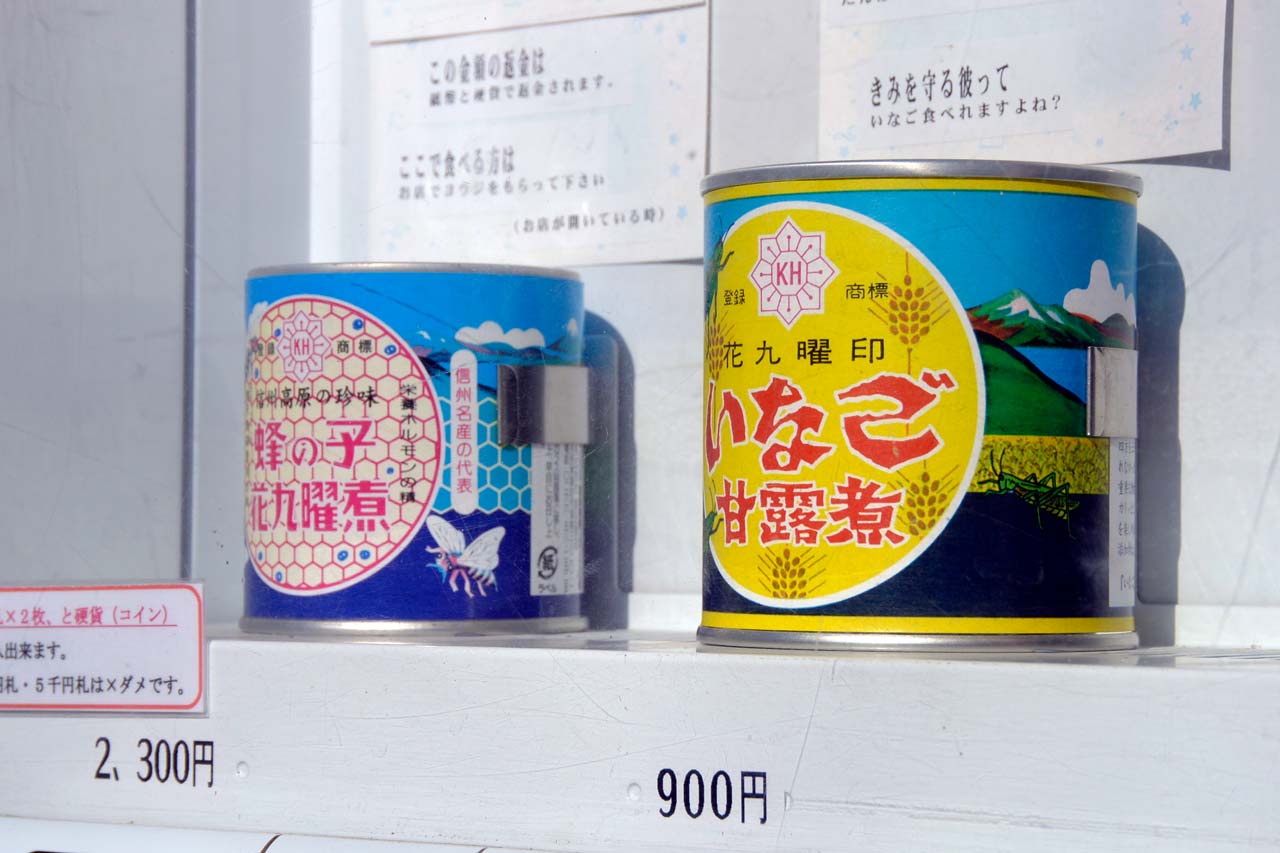
Kanroni 甘露煮 is similar to tsukudani, but has more sugar and tastes sweeter. Hanakuyouni 花九曜煮 is a certain brand of tsukudani food in Japan. It uses it’s original recipe to stew the bee larvae for this product.
So next time you’re going for a jog in this Tokyo park, swing your sweaty self over to this vending machine and start guzzling bee larvae. Nothing prepares you for long distance running better than a belly full of insect babies!
Of course, if you don’t need the express convenience of vending machines, you can always order these exact cans on Amazon.
But these days, even Amazon is pretty quick, so you might not be waiting long.
Japanese Canned Insect Review
I know you are curious to find out how bugs taste, so two brave Tofugu members, Koichi and Michael, tasted these instant bugs for you. Koichi has experience cooking and eating crickets from back in middle school (he made cookies topped with crickets for a cookie contest). But, it was the first bug food experience for Michael.
For this "eating bugs video," we prepared the Hanakuyoujirushi brand canned insects, the same as I introduced above; inago (rice grasshoppers) and hachinoko (bee larvae).
We opened the cans. The rice grasshoppers were smaller than I expected (I think the ones I ate at my grandma’s house were bigger), but they still kept their shape.
The bee larvae looked like tiny beans unless you looked at them close up. Some are semi-adults, and we enjoyed seeing the difference.
Koichi has experience cooking and eating crickets from back in middle school (he made cookies topped with crickets for a contest). But it was the first bug food experience for Michael.
I topped the rice with bugs. Koichi and Michael skipped their breakfasts, so it was the perfect lunch for them. It looks delicious just like other Japanese tsukudani dishes, doesn’t it?
In the end, both of them really enjoyed the Japanese edible bugs (as you saw in the video). I thought it would take them longer to take the first bite, but surprisingly, they didn’t hesitate. Koichi liked the nut-like crunch of the inago, and the flavor of the bee larvae reminded Michael of Kewpie white sesame dressing.
Insects Commonly Eaten in Japan
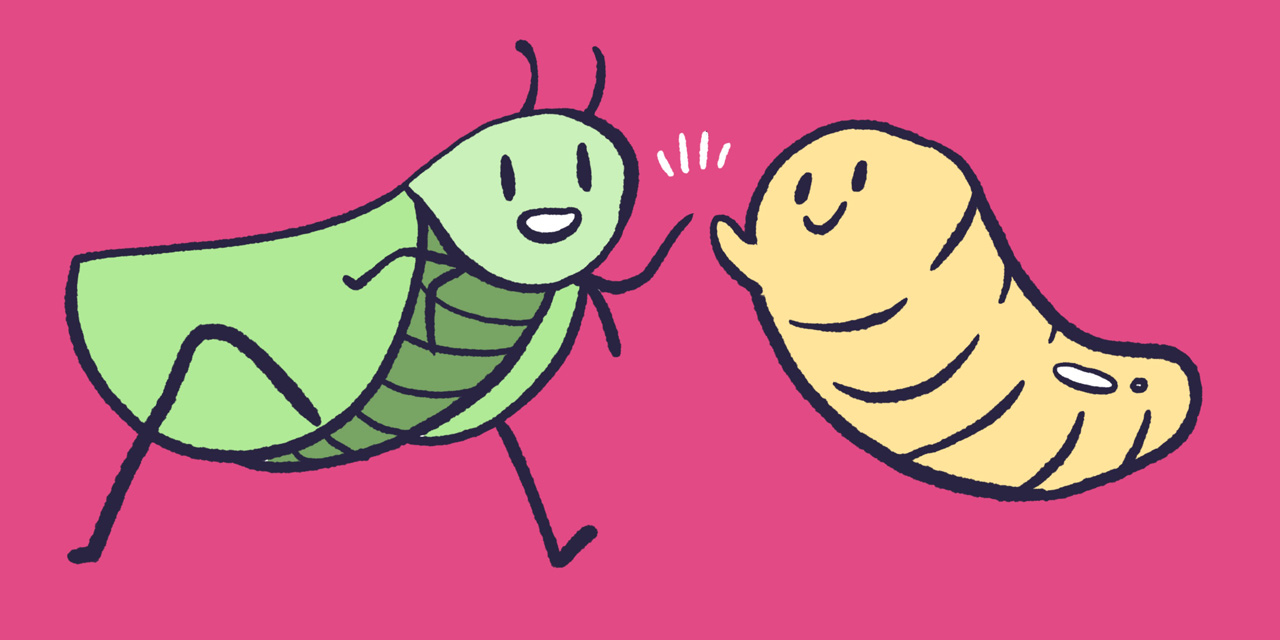
You’ve already seen many kinds of bugs in this article. But don’t think all Japanese people eat all kinds of bugs. Besides the mecca prefecture of edible bugs (Nagano), we are familiar with only certain types of food-able insects. Let me introduce some of the most common bugs eaten in Japan.
Rice Grasshoppers いなご
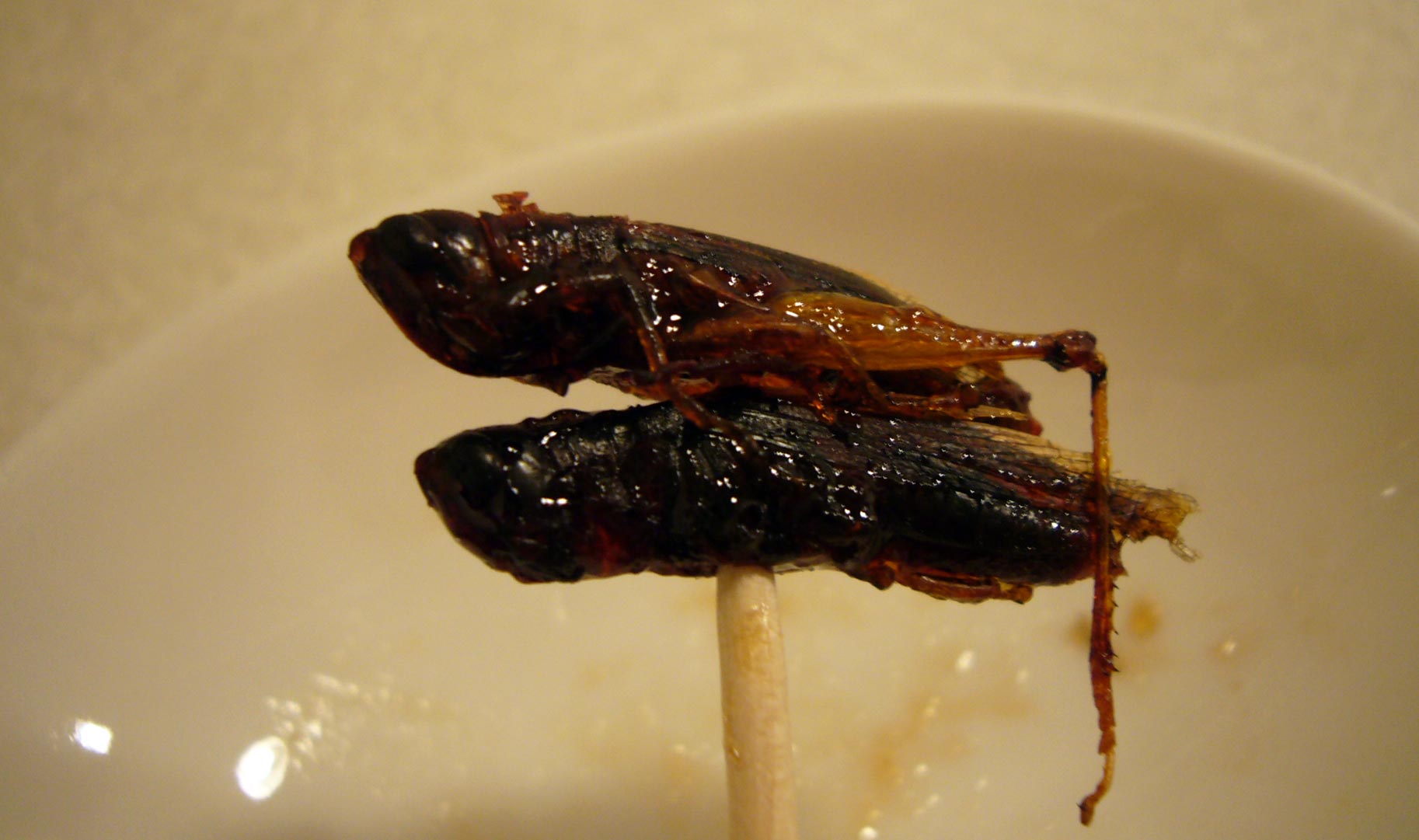
Rice grasshoppers, or inago 稲子, are the most common bugs eaten in Japan. They’re pests that eat rice crops, so people used to catch them in the rice field and eat them as a tasty snack. However, they’re not as common nowadays because their agricultural chemicals keep their numbers down. Without a practical reason to munch on hoppers, people have had to start eating them on purpose.
Inago are usually served as tsukudani. Personally, they remind me of coffee flavored candy. They’re sweet, but also salty because of the soy sauce. The strong salty-sweet (amajoppai 甘じょっぱい ) taste covers the grasshoppers natural buggy flavors. It removes the earthy, grassy taste too.
Inago is a good accompanying dish with rice (okazu おかず). Also, the crunchy texture is a good match with booze or tea, so you can enjoy them as bar snacks ( otsumami おつまみ) or as an afternoon treat (oyatsu おやつ).
Bee larvae 蜂の子
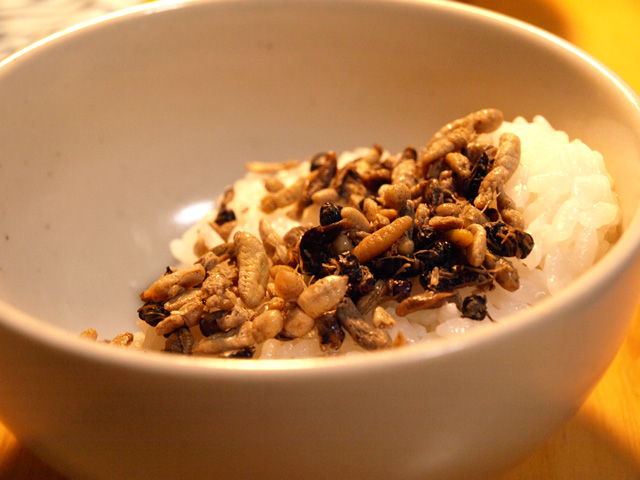
While rice grasshoppers are common as a home-style dish, bee larvae, or hachinoko 蜂の子, are considered to be fancier. You can find canned bee larvae (on amazon or in the vending machine), but they’re usually much more expensive than inago.
Although they look similar to maggots, bee larvae are a traditional delicacy in some regions (including the edible bug mecca Nagano prefecture). They have different names depending on the region.
In Nagano, they’re called sugara すがら, sugaru すがる, or sugare すがれ. In Gifu, they’re called hebo へぼ, and they also cook bee larvae with rice and call it hebomeshi へぼめし.
You can even find bee larvae at fine restaurants. Yanagiya, a regional cuisine restaurant in Gifu that’s considered the best restaurant in Japan on Tabelog (Japan’s answer to Yelp), serves kanroni of bee larvae as an appetizer.
Bee larvae are well-balanced and nutritious. Some people believe they can help treat many kinds of sicknesses and are anti-aging because of the nutrients they provide that your body can’t produce. The health benefits of hachinoko has been coveted for ages. In China, they’ve been eaten as natural supplements for over 2,000 years!
Silk Pupae 蚕のさなぎ
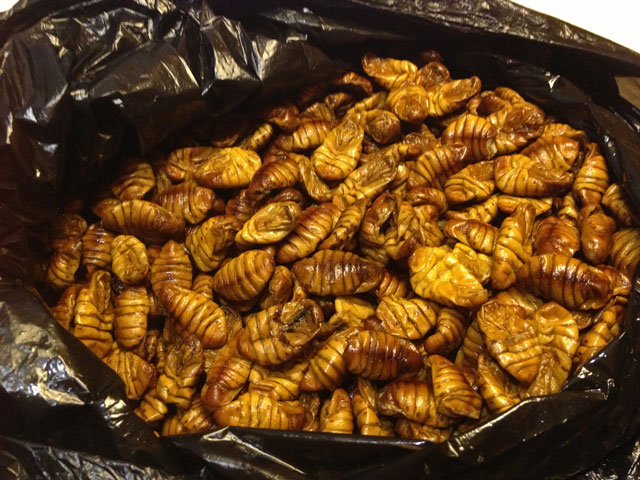
The history of kaikonosanagi 蚕のさなぎ, or silk pupae, is so long that it's recorded in the Kojiki 古事記, Japan’s oldest history book. They’re the only animal that can’t survive without human intervention. Silk pupae are also eaten in China and Korea (probably more than Japan).
Like other edible insects, silk pupae are nutritious. People used to eat them instead of beef or pork because of their rich fat and protein content (not to mention vitamin B2). Some say the nutrition of three pupae is equal to one chicken egg!
It used to be more common as a food in Japan when silk manufacturing was flourishing. However, now Nagano prefecture, the mecca for eating bugs in Japan, seems to be the only place where you can find silkworm foods. The common ways to prepare silk pupae is in tsukudani or kanroni.
Personally, I’ve seen and touched silk worms and pupae when I was in elementary school, since we grew them for our science class, but I’ve never eaten them. They’re often used as fishing bait, but many people outside of Nagano might not be familiar with them as food anymore.
Eating Bugs in Japan: Resources
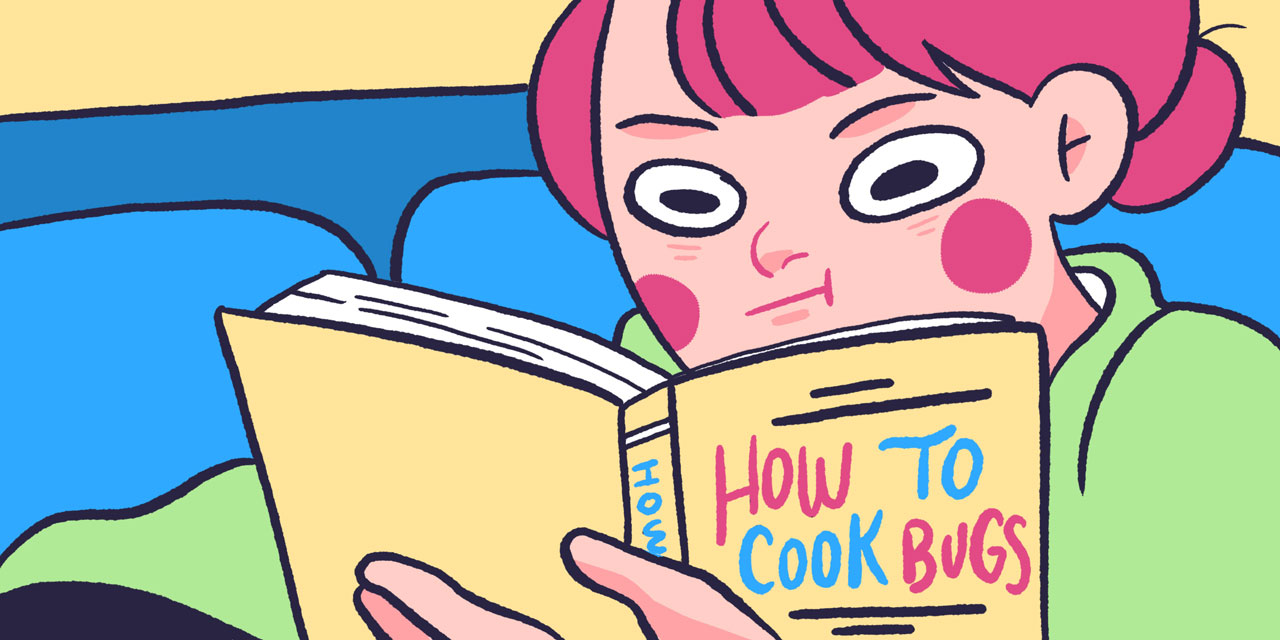
Now that you're becoming a fan of Japanese entomophagy (you are, aren't you?) you gotta get your bug-eating otaku goods. Celebrate your newfound diet with these books, movies, and more.
Bug Eating Walk 2033 Photobook
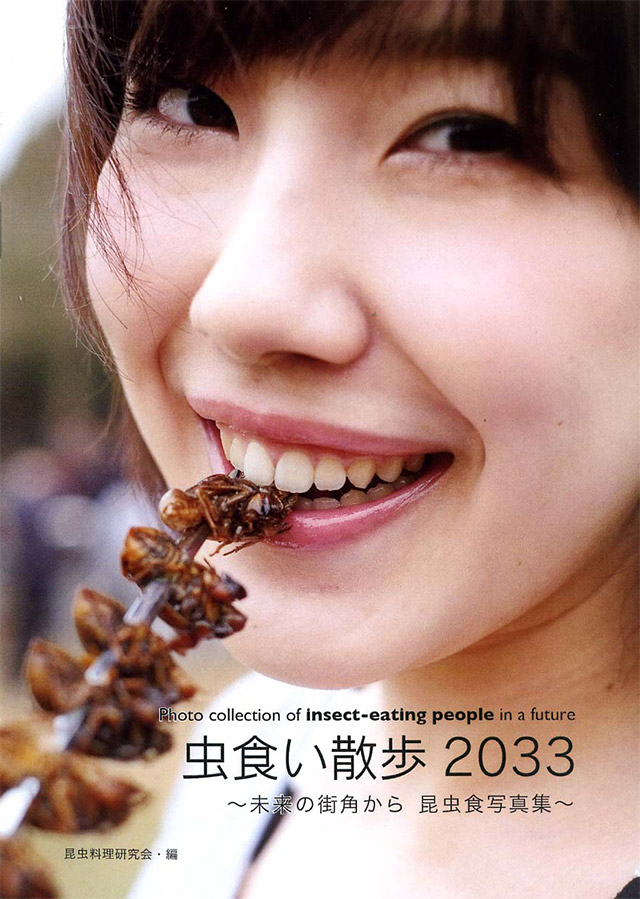
This is a cover of a photobook by Kohta Nunokawa, mushikui sanpo 2033 虫食い散歩2033 (Bug Eating Walk 2033), which reflects the image of our near future in 2033 when people eat bugs regularly. You can enjoy seeing cute Japanese girls eating bugs in daily life as if they’re having a bite of a Pocky stick. It might look a little crazy now, but this is where our future is headed. The book says so.
Japanese Entomophagy Blog
Insect Meal「むしくい」 is a blog about eating bugs in Japan. It’s right there in the title (mushikui むしくい means "Eating Bugs). The owner, Mushimoazerugiriko, is a freelance writer who specializes in edible insects. She offers her bug recipes, events, and any bug-related stuff that she can find (even Boys’ Love manga about anthropomorphic bugs).
Japanese Entomophagy Documentary
A documentary called Mushikui ムシクイ (same name as the blog above but written in katakana) is a movie that examines the bug expert Mr. Uchiyama’s life, including his home farming of cockroaches and interviews by foreign media.
You can order a DVD on Rakuten so do it now!
Bug Eating Manga
Chushoku 蟲★喰 is a manga anthology about manga artists who try to catch, cook, and eat different edible bugs. Then they write a story about the extraordinary experience. It’s an educational manga which is perfect for edible bug beginners who want to know what kind of bugs they can eat. Educational! Their website even shows the basic knowledge of bug cooking and recipes.
Insect Tsukudani Shops
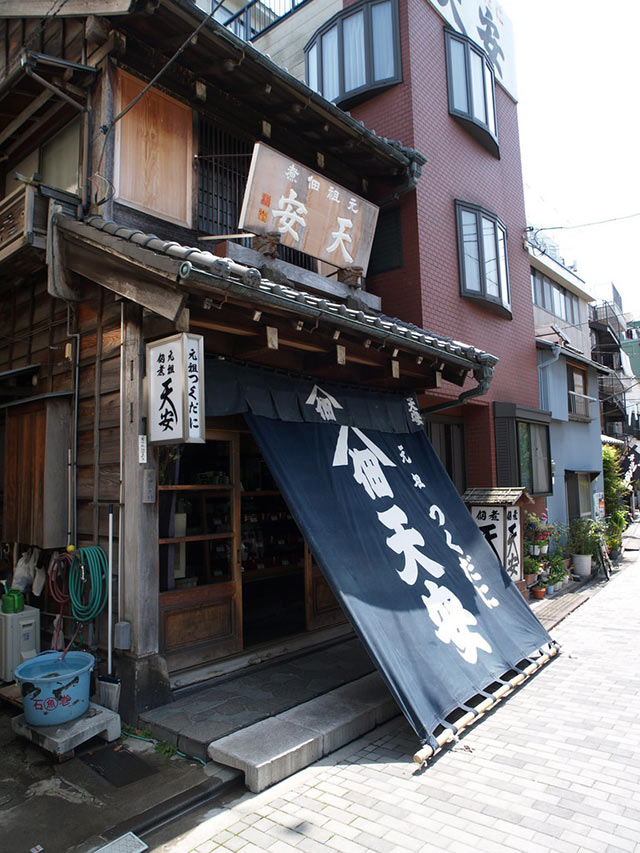
If you’re looking for edible bugs to buy as omiyage from your trip to Japan, tsukudaniya 佃煮屋, traditional tsukudani shops are the place to go. They have tsukudani of various ingredients including vegetables, seafood, or nuts, but usually, they also have insect tsukudani.
Here are a few you can visit on your next trip to Japan:
Tenyasu (Tokyo) * Address: 1 Chome-3-14 Tsukuda, Chūō-ku, Tōkyō-to 104-0051, Japan * Telephone: 03-3531-3457 * Website: http://tenyasu.jp/ * Notes: Rice grasshoppers tsukudani are available from October to April
Yasuiya (Tokyo) * Address: 1 Chome-15-14 Minamisenju, Arakawa-ku, Tōkyō-to 116-0003, Japan * Telephone: 03-3891-0645 * Website: http://www.yasuiya.co.jp/
Tsukahara Shinshu Chinmi (Nagano) * Address: 2570-1 Kamishinden, Ina-shi, Nagano-ken, Japan * Telephone: 0265-76-0591 * Website: http://www.tsukahara-chinmi.com/
Eating Bugs by Choice, Not Out of Necessity
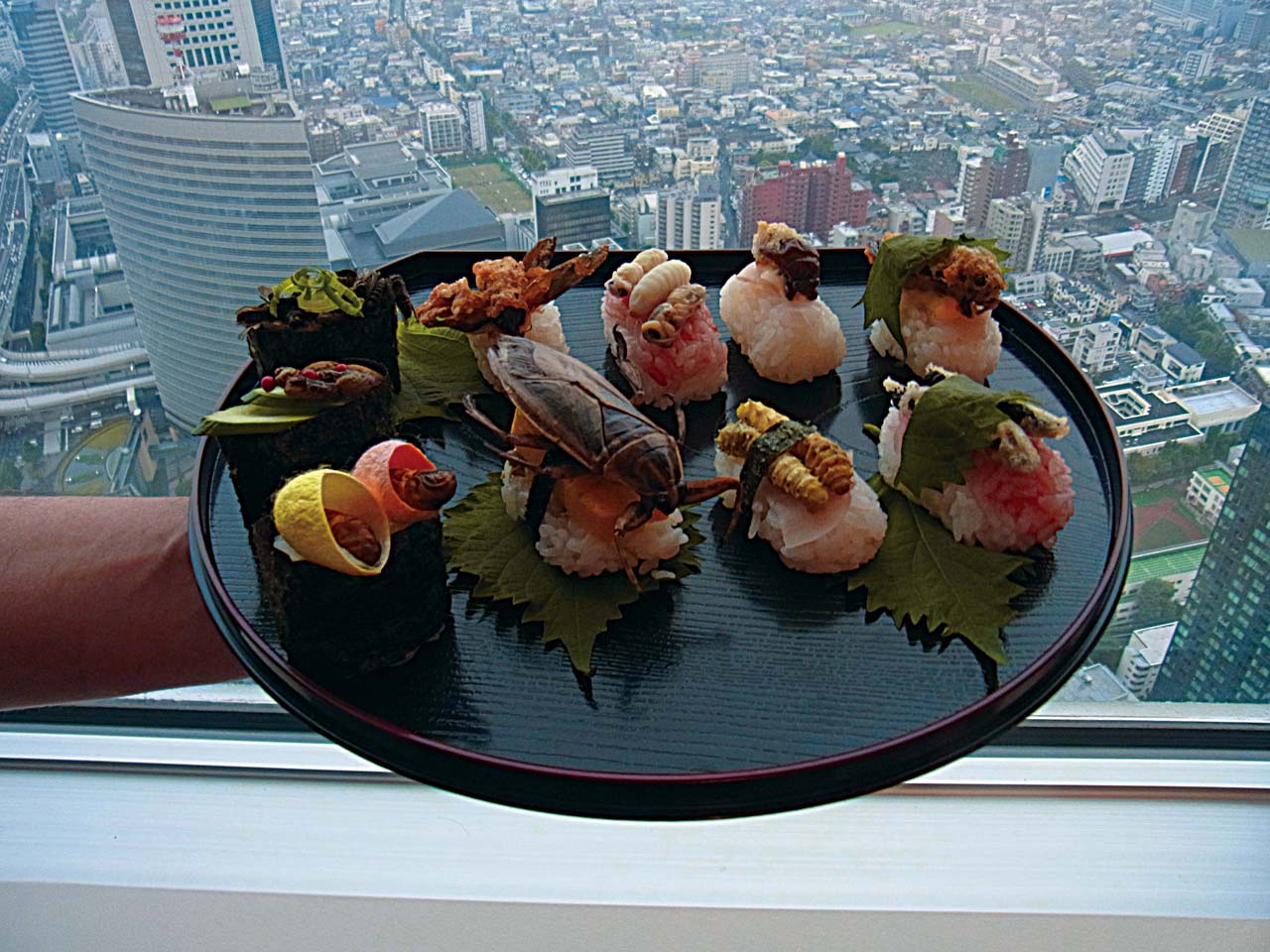
In Japan, many people think edible insects are not a desirable choice, because they used to be eaten during times of poverty. But why stop eating something that is sustainable and healthy just because you view it as "unworthy"? The "grossness" of insects as food might be a psychological barrier people have to overcome. If you’ve got this kind of mental block against insects, you might want to start your edible insect diet with something that doesn’t look so buggy. For example, cooking with cricket flour or cricket bars made by Exo.
I’m really excited to see where our food culture is headed. You still might feel weird about eating bugs. It might be hard to imagine yourself eating them regularly, but remember sushi? Westerners used to avoid raw fish, but now sushi is one of the most popular foods in western countries. And what about lobster? Many call them the "cockroaches of the sea" (scientifically, lobsters are insects). If we pay tons of money for lobster, why not pay a little for other tasty bugs?
Bugs are cheap, easy to grow, and above all healthy. Will you be trying edible insects in the near future?
-
Source: Mie University ↩
